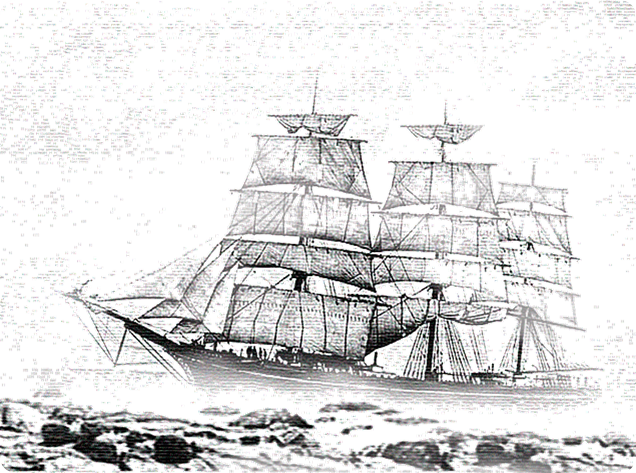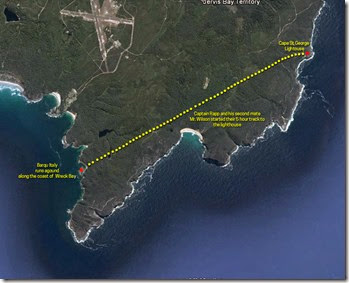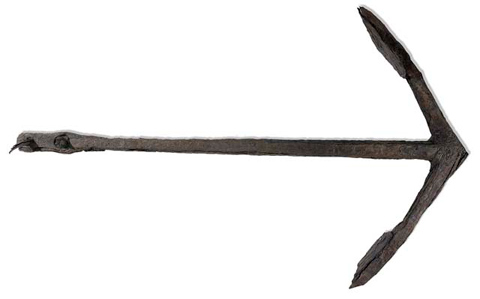| The story of seafaring along the east coast is awash with stories of hardship, despair and melancholy, but there are also stories of luck, near misses and close encounters. If the wind shifted, or the anchor did not take hold, or if the sea conditions changed for the worse, many close encounters could have turned into disaster. Starting off this series of “close encounters” is the story of the Barque Italy in 1877. | ||||
 | ||||
 | ||||
| Reconstruction of the Barque Italy, enveloped in fog and ashore at Wreck Bay. | ||||
| As reported by Captain Rapp. Saturday 2nd June 1877. Sailed from Hobart Town on the morning of Saturday, 2nd instant. Had light variable winds with remarkable fine weather until Sunday morning. Sunday 10th. When the weather set in thick, foggy and showery, at intervals clearing a little (wind south) during the night. Monday 11th. 9am, on the 11th, sighted Pigeon House, the bearings agreeing with the reckoning. During the afternoon caught a glimpse of the land twice through the fog. At 1pm. a glimmer of light like a flash or revolving light to the south and westward, where we expected to see Jervis Bay light. We were then going at the rate of five or six knots, steering north1/2 east, wind south, veering to south west; had two men on the lookout forward. At 7p.m. the barque Adeline Burke, which vessel had been steering towards us from the eastward, was then nearly ahead. At 7.35 the second mate told me he saw land, and on looking saw land on the starboard beam; ordered the helm to be put starboard, but immediately after, hearing breakers and seeing land ahead, on the port side, I ordered and assisted to put the helm hard aport. Before the ship could answer her helm she struck on a flat out lying rock, turned off and forged partly over, hanging on it by her heel about fifty yards from shore. We had everything aback; waited sometime; found she would not move; stowed the sails and cleared the boats ready for lowering; sounded the pumps and found she was not making any water. The night being very dark and foggy we could not see any land, only rocks and breakers; lighted some touches and sent the second mate with three hands in the boat to make a line fast on shore on the port bow. At 11p.m. the ship heeled over much as the tide left her, wind and sea rising, with every indication of easterly weather; we all landed safely. Tuesday, 12th. At daylight, went on board, sounded the pumps, and noted our position; ran out kedge anchor and line; put out the long boat and laid out stream anchor and chain; got tent and stores on shore. Captain Rapp went in search of assistance; after three hours of fruitless travelling he returned on board; started again at 1pm, taking Mr. Wilson, the second mate and compass, making in a straight line for Cape St George lighthouse. 5 hours walking through dense scrub seeking assistance. After five hours’ walking through dense scrub, over hills, and through creeks and swamps, when within half-a-mile of the lighthouse, Captain Rapp, being unable to proceed further, sent the second mate on, who with Mr Gibson, the superintendant, returned; between them they managed to bring him to the lighthouse, where dry cloths and good treatment bought him around, and the following day with horses and a guide went back to the ship. | ||||
 The walk for help. The walk for help. | ||||
| Wednesday, 13th. Put out springs and breastwarps; then began to lighten the ship; weather fine and sea smooth. Thursday, 14th. Fresh breezes and sea rising; hauled a longboat up a creek, and pumped the water out of the ship; weather looking threatening, landed some provisions. 8p.m. tide, wind, and sea rising, the ship went ahead on the rock into 12ft of water, parting all the wasps, only the stream anchor holding her; bumping very hard all night. Thursday, 14th. went on board at daylight, found 6ft of water in her, picked up the broken wasps and made all fast again then took to the pumps, employing some blackfellows to assist. 5p.m., reduced the water to two feet. The steamer Woniora coming to our assistance took her hawser; then commenced boating off the undamaged portion of the landed cargo. | ||||
11p.m, wind and sea rising, deeming it advisable to abandon the longboat, anchors, and other gear ; hove up the anchor, and towed to Sydney. Captain Rapp speaks highly of the kindness of Mr Gibson, the superintendent of the Jervis Bay lighthouse, and also of Mr. Lovegrove Shoalhaven, who was in assistance and gave all assistance in his powers. Meaning: Warp - A line or cable used in warping a ship. Stream Anchor - A light anchor for use with a bower in narrow waterways. Kedging or warping - Is a technique for moving or turning a ship by using a relatively light anchor. Kedge anchor - is an anchor carried in addition to the main. Aport - On or toward the port or left side of a ship. | ||||
 | ||||
| REF: Trove. http://trove.nla.gov.au/ndp/del/article/18820092 |
13 January 2015
Close encounters.
Subscribe to:
Post Comments
(
Atom
)



No comments :
Post a Comment